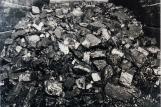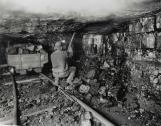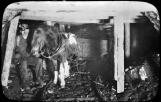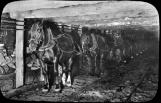2
Before oil became the way of life in Alberta, it was coal that fuelled the fire under our economy. Although the coal industry developed late in Alberta compared to the East Coast of Canada, Alberta's output rivaled Nova Scotia's by the First World War. The rapid growth of the industry and the fact that the valley was a leading producer in domestic coal, soon earned Drumheller title of Coal Capital of Alberta.5
Between 1911 and 1921, most of the coal mines in the valley relied on manual labour to extract the coal. These techniques were developed in Europe and later adapted for use in North America. They required skilled miners, mostly from Eastern Europe, and required little machinery to get the job done.6
Rosedeer Coal Mine, two miners at the coal face, loading coal into a coal carBetween 1912 - 1934
Wayne, Alberta
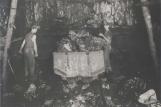 Credits:
Credits:The Town of Drumheller
7
A great majority of the mines in the valley were drift, shaft or slope mines. Drift mines were the most common in the valley and were dug directly into the hill at the level of the seam. Slope mines on the other hand were a passage to the coal seam on a slight angle or grade. A shaft mine has a hoist straight down from the surface directly to the seam. There were even a few small strip mines. At a strip mine the coal is extracted by first removing all of the overburden or earth covering up the recource. Most coal mines today in Canada are large strip mines.8
Diagram of different mining styles used in the Drumheller Valley Credits:
Credits:Atlas Coal Mine Historical Society
9
Underground, Rosedeer Coal Mine, two miners at the face, pick miningBetween 1912 - 1934
Wayne, Alberta
 Credits:
Credits:The Town of Drumheller
10
Most mines of the time were room and pillar style. Underground, these mines were set up like a city with a grid of streets and avenues. Openings called rooms were excavated in the coal seam and were separated by pillars of coal left in place to support the roof.12
In the early days there was usually one miner and one helper in each room. The miner used his pick to make a trench in the coal face. This trench provided a space to absorb the explosion. Then with a hand auger he drilled several holes for explosives. Once the holes were drilled, the fireboss would load the explosives and shoot down the coal.Once the coal was dislodged it was manually loaded onto a coal cars and hauled out of the mine by pit ponies.
13
Five ponies and five men on surface break. Note cloth caps.1920's
Drumheller, Alberta
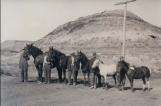 Credits:
Credits:Atlas Coal Mine Historical Society
